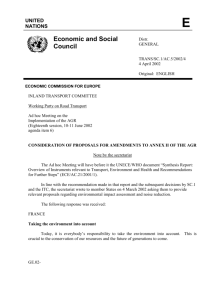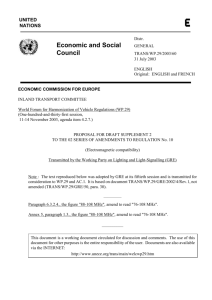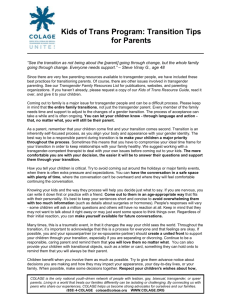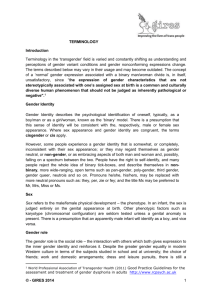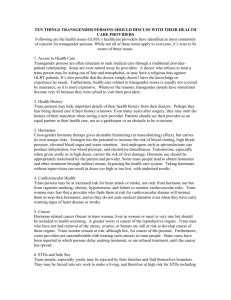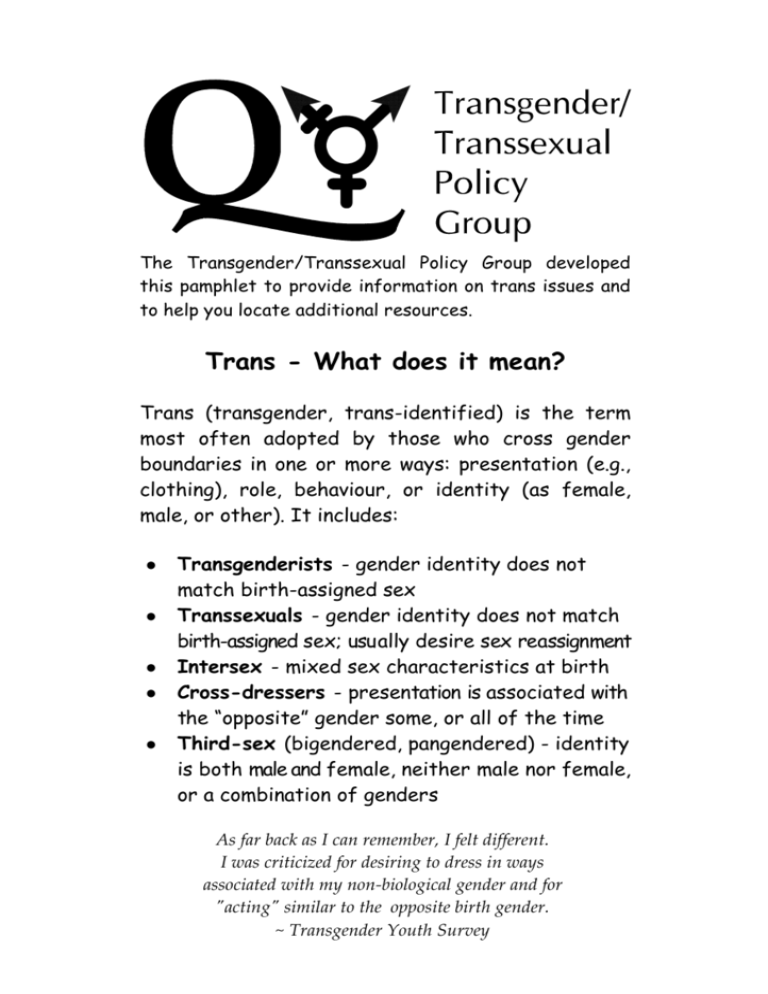
The Transgender/Transsexual Policy Group developed
this pamphlet to provide information on trans issues and
to help you locate additional resources.
Trans - What does it mean?
Trans (transgender, trans-identified) is the term
most often adopted by those who cross gender
boundaries in one or more ways: presentation (e.g.,
clothing), role, behaviour, or identity (as female,
male, or other). It includes:
Transgenderists - gender identity does not
match birth-assigned sex
Transsexuals - gender identity does not match
birth-assigned sex; usually desire sex reassignment
Intersex - mixed sex characteristics at birth
Cross-dressers - presentation is associated with
the “opposite” gender some, or all of the time
Third-sex (bigendered, pangendered) - identity
is both male and female, neither male nor female,
or a combination of genders
As far back as I can remember, I felt different.
I was criticized for desiring to dress in ways
associated with my non-biological gender and for
"acting" similar to the opposite birth gender.
~ Transgender Youth Survey
Frequently Asked Questions
Why don’t I know any trans people?
You probably do - you just don’t know they are trans.
Most trans people do not disclose or express their true
gender; however, a growing number are coming out and
insisting on having their rights respected. There are
trans students, staff and faculty at Queen’s.
Are there both male and female trans people?
There are likely equal numbers of female and male
trans people; but, because transsexual men (female-tomale) “pass” more easily, they tend to be less visible
than transsexual women. Similarly, there seem to be
fewer female-to-male cross-dressers, as it is more acceptable for women to wear “male” clothing.
Aren’t transsexuals just lesbians and gay men
who can’t accept their sexual orientation?
Sexual orientation differs from gender identity. A
trans person may be heterosexual, lesbian, gay or bisexual. Often trans people who are heterosexual are
assumed to be same-sex oriented by those who focus
only on biological gender cues.
Who are cross-dressers?
The majority of cross-dressers are heterosexuals who
are comfortable with their gender and sexual identities. People cross-dress to shed their usual gender role
or for performance (drag queens, drag kings). As noted
above, female-to-male cross-dressers tend to be least
visible.
We’re born naked, and from there it’s all drag. ~ RuPaul
Discrimination
Transphobia refers to negative attitudes and behaviour
towards those who do not conform to conventional conceptions of gender. Trans people, lesbians, gay men, bisexuals and their supporters are typically the targets of
transphobia. It is pervasive in mainstream culture and
results in people being rejected, harassed, assaulted,
even murdered because they do not adhere to gender
norms. Trans people are denied access to a broad range
of services, including medical care and social services.
Transphobia, heterosexism and sexism are closely linked,
with each reinforcing gender stereotypes and roles.
It's not only people who intentionally transgress gender
who get into trouble. Eventually the gender system
lets everyone down. It seems to be rigged that
way. Sometimes, even with all the time
and effort we put into obeying the
rules, we get hurt. We can get
badly hurt by being a real
man or a real woman.
~ Kate Bornstein
What is Queen’s doing?
The rights of trans people are protected by human
rights codes and the Queen’s Harassment/
Discrimination Policy. Gender identification is a ground
of prohibited discrimination in our policy. The Transgender/Transsexual Policy Group has been working to
increase trans accessibility in residences, employment
and campus services. Because of the discrimination
shared by gender and sexual minorities, lesbian, gay, bisexual, and trans groups have evolved on campus.
As a bigendered person I present both masculine
and feminine identities alternately with equal comfort.
I value and honor both gender roles and spend roughly equal
time in each. It is analogous to being bilingual.
~ Sharon Ann Stuart (in Feinberg)
What can you do?
Educate yourself on gender and trans issues
Watch films, read books, attend a workshop
Identify your own gender biases: what’s your stake in
maintaining rigid gender roles?
Challenge transphobic remarks and jokes whenever
possible
Incorporate gender diversity and trans issues into
your curricula and class discussions
Invite trans speakers for seminars, workshops, films
and discussion groups
Support local trans events and activists
The problem with transexual women is not
that we are trapped in the wrong bodies. The truth is
that that is a fairly trivial affair corrected by doctors and
sharp scalpels. The problem is that we are trapped in a
society which alternates between hating and ignoring,
or tolerating and exploiting us and our experience.
~ Riki Anne Wilchins
For More Information
Visit our web page at www.queensu.ca/humanrights
and click on TG/TS Policy Group. Or check out these
resources:
At Queen’s
Coming Out, Living After Discussion Group
comingoutdiscussiongroup@yahoo.ca
Education on Queer Issues Project - 533-2725
http://www.myams.org/sic/equip.asp
Human Rights Office - 533-6886
http://www.queensu.ca/humanrights
Positive Space Program
http://www.queensu.ca/humanrights
posspace@post.queensu.ca
In the Kingston Community
HIV/AIDS Regional Services - 545-3698
http://www.hars.ca
Kingston Pride Committee
http://www.kingstonpride.org
Out in Kingston Web Site
http://www.outinkingston.org
Books, documents and videos are available
at the Stauffer Library and the
Human Rights Office
The Internet
(all preceded by www.)
Gender Education and Advocacy - gender.org
International Found. for Gender Ed - ifge.org
Intersex Society of North America - isna.org
PFLAG - pflag.org
Trans Family - transfamily.org
Films
(available at local video stores)
Transamerica (2005)
Normal (2003)
By Hook or By Crook (2001)
Almost Human (2000)
Hedwig and the Angry Inch (2000)
Flawless (1999)
Boys Don’t Cry (1999)
All About My Mother (1999)
Ma Vie En Rose (1997)
Documentaries
Transgeneration (2005)
Gender Euphoria (2003)
Just Call Me Kade (2003)
In the Flesh, In the Heart . . . (NFB, 2000)
Southern Comfort (2000)
The Brandon Teena Story (1998)
You Don’t Know Dick (1996)
Printed by the Queen’s Human Rights Office
I’m a Black, gay performance artist – man enough to let his
woman shine and woman enough to let his man roar.
~ Craig Hickman (in Feinberg)
(2002, 2004, 2006)





